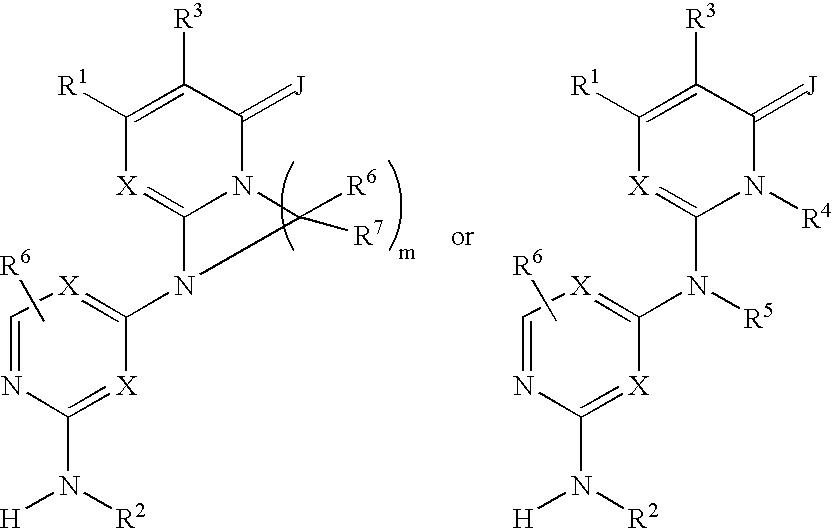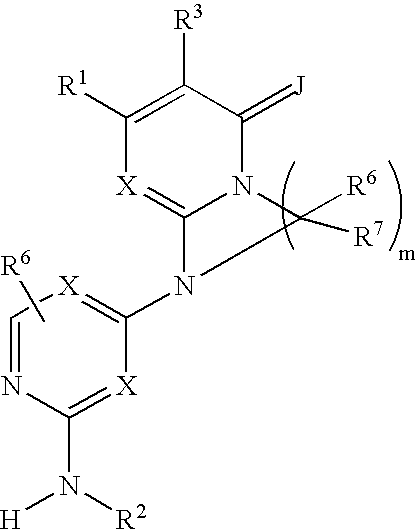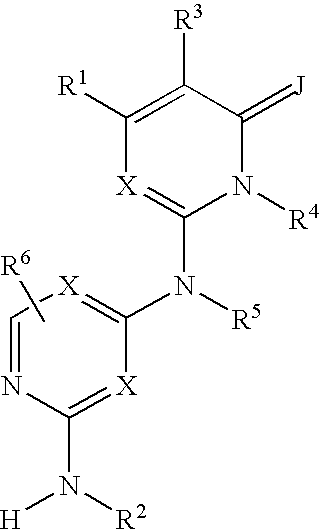Substituted heterocyclic compounds and methods of use
a heterocyclic compound and substitute technology, applied in the field of substitution heterocyclic compounds and methods of use, can solve the problems of small blood vessel adherence and significant neutrophil accumulation in capillaries
- Summary
- Abstract
- Description
- Claims
- Application Information
AI Technical Summary
Benefits of technology
Problems solved by technology
Method used
Image
Examples
example 1
[0134]Tetrahydro-pyrimidin-2-ylideneamine hydrochloride: A suspension of 1,3-diaminopropane (74 g, 1 mol) and guanidine hydrochloride (76 g, 0.8 mol) was heated to 140° C. while stirring for 20 h. Reaction temperature lowered to 100° C. and isopropyl alcohol (100 mL) added. At room temperature resulting solid collected by filtration and solid washed with diethyl ether. Air dried overnight. White powder. M+1=100.
[0135]3-(3,4-Dimethyl-phenyl)-3-oxo-propionic acid methyl ester: To a stirring solution of 3,4-dimethylacetophenone (1.0 g, 6.8 mmol) in tetrahydrofuran (10 ML) at 0° C. under an atmosphere of nitrogen was added potassium hexamethyldisilylzide (1.46 g, 6.8 mmol). Resulting suspension was stirred for 10 min and dimethylcarbonate (0.58 mL, 6.8 mmol) added. Reaction stirred for 16 h warming to room temperature then poured onto wet ice (50 mL) / hydrochloric acid (5 mL). Product extracted with ethyl acetate (50 mL) and organic washed with saturated sodium chloride then dried over...
example 14
[0144]9-(2-Methylsulfanyl-pyrimidin-4-yl)-3-nitro-2-phenyl -6,7,8,9-tetrahydro-pyrimido[1,2-a]pyrimidin-4-one: To a stirring solution of 9-(2-methylsulfanyl-pyrimidin-4-yl)-2-phenyl-6,7,8,9-tetrahydro-pyrimido[1,2-a]pyrimidin-4-one (500 mg, 1.42 mmol) in dichloromethane (10 mL) at 0° C. under nitrogen was added nitronium tetrafluoroborate in a 0.5M solution (7 mL, 3.55 mmol). External cooling removed and reaction warmed to room temperature while stirring for 1 h. Reaction washed with 5% sodium bicarbonate and saturated ammonium chloride. Organic concentrated under vacuum and orange solid isolated after purification on silica. M+1=397.
[0145]9-(2-Methanesulfonyl-pyrimidin-4-yl)-3-nitro-2-phenyl -6,7,8,9-tetrahydro-pyrimido[1,2-a]pyrimidin-4-one: To a stirring solution of 9-(2-methylsulfanyl-pyrimidin -4-yl)-3-nitro-2-phenyl -6,7,8,9-tetrahydro-pyrimido[1,2-a]pyrimidin-4-one (235 mg, 0.59 mmol) in acetonitrile (2 mL) and trifluoroacetic acid (2 mL) at 0° C. under an atmosphere of nitro...
example 19
[0153]1-Bromo-3-(2-nitro-propenyl)-benzene: A suspension of 3-bromo-benzaldehyde (2.5 g, 13.5 mmol), ammonium acetate (1.09 g, 14.2 mmol), and nitroethane (250 mL) was heated to reflux overnight. Solvent removed under vacuum then residue partitioned between ethyl acetate and saturated sodium chloride. Concentrated organic purified on silica and isolated as a yellow oil. 1H NMR (CDCl3) s (3H, 2.44 ppm), m (2H, 7.35 ppm), m (2H, 7.55 ppm) s (1H, 8.00 ppm).
[0154][2-(3-Bromo-phenyl)-1-methyl-ethyl]-carbamic acid tert-butyl ester: To a stirring solution of lithium aluminum hydride (24 mL of 1 M in tetrahydrofuran (THF), 24 mmol) at 0° C. under an atmosphere of nitrogen was added sulfuric acid (0.61 mL, 12.0 mmol) in tetrahydrofuran (10 mL) dropwise. Then a solution of 1-bromo-3-(2-nitro-propenyl)-benzene (1.17 g, 4.8 mmol) in THF was added dropwise via an addition funnel. Reaction warmed to room temperature overnight. Reaction chilled to 0° C., and a saturated solution of potassium sodiu...
PUM
| Property | Measurement | Unit |
|---|---|---|
| Rg | aaaaa | aaaaa |
| Rg | aaaaa | aaaaa |
| temperature | aaaaa | aaaaa |
Abstract
Description
Claims
Application Information
 Login to View More
Login to View More - R&D
- Intellectual Property
- Life Sciences
- Materials
- Tech Scout
- Unparalleled Data Quality
- Higher Quality Content
- 60% Fewer Hallucinations
Browse by: Latest US Patents, China's latest patents, Technical Efficacy Thesaurus, Application Domain, Technology Topic, Popular Technical Reports.
© 2025 PatSnap. All rights reserved.Legal|Privacy policy|Modern Slavery Act Transparency Statement|Sitemap|About US| Contact US: help@patsnap.com



